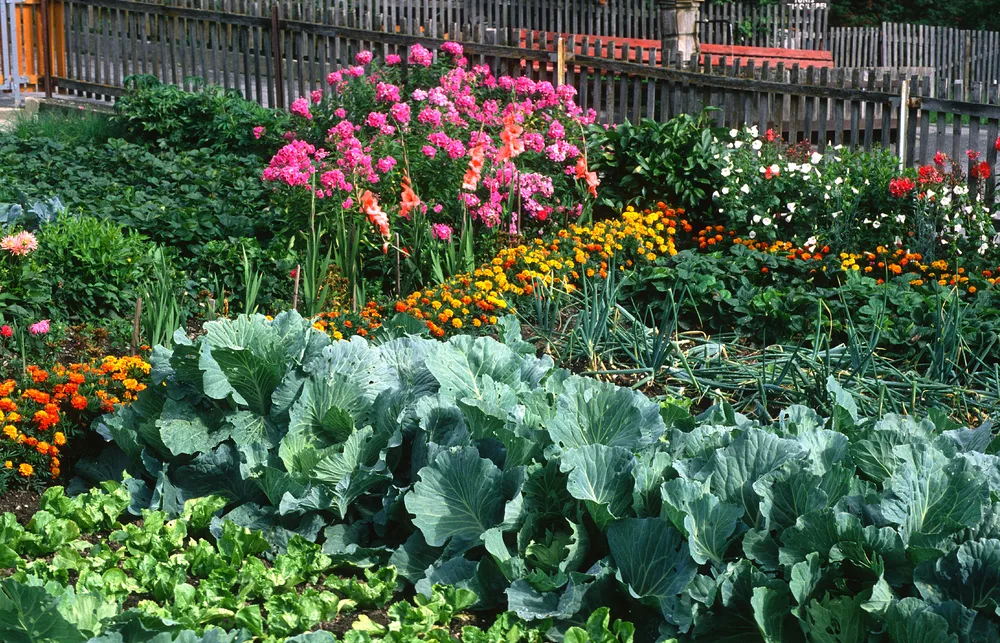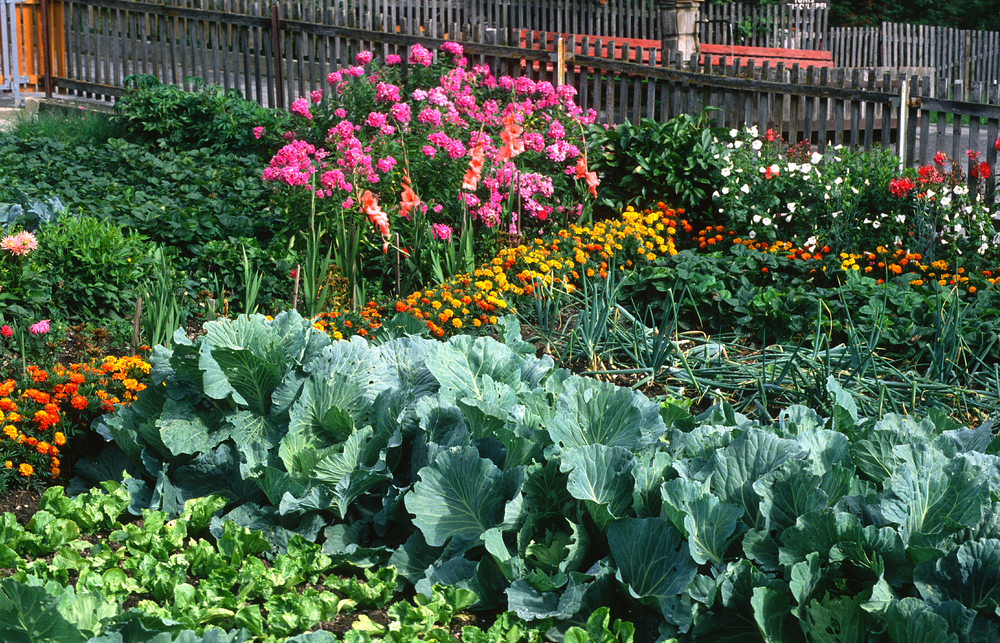Grow A Healthy Harvest Of Red Cabbage With These Companion Plants
Grow a Healthy Harvest of Red Cabbage with These Companion Plants
Red cabbage is a delicious and versatile vegetable that can be enjoyed in a variety of dishes. It's also a relatively easy crop to grow, but there are a few things you can do to help ensure a healthy harvest. One of the most important things is to choose the right companion plants.
Companion planting is the practice of planting certain types of plants together to benefit each other. There are many different companion plants that can be beneficial for red cabbage, but some of the best include:
- Marigolds: Marigolds are known for their insect-repelling properties, and they can help to keep cabbage moths and other pests away from your plants.

- Onions: Onions release sulfur compounds into the soil, which can help to deter cabbage root maggots.

- Carrots: Carrots and cabbage have different growth habits, so they won't compete for space. They also both benefit from the same type of soil, so planting them together can help to improve the overall health of your garden.

- Beans: Beans are nitrogen-fixing plants, which means they can help to add nitrogen to the soil. This is beneficial for cabbage, as it's a heavy feeder that requires a lot of nitrogen.

- Peas: Peas are also nitrogen-fixing plants, and they can help to attract beneficial insects to your garden.

In addition to these specific companion plants, there are a few general principles that you can follow when companion planting red cabbage. For example, it's a good idea to avoid planting cabbage near other brassicas, such as broccoli, cauliflower, and Brussels sprouts. This is because these plants are all susceptible to the same pests and diseases, so planting them together can increase the risk of infection.
It's also important to consider the spacing requirements of your companion plants. For example, marigolds need full sun, while onions and carrots prefer partial shade. So, if you're planning to plant these plants together, you'll need to make sure that they have enough space to grow properly.
By following these tips, you can help to ensure a healthy harvest of red cabbage. So, next time you're planning your garden, be sure to include some of these beneficial companion plants.
[Main Content]
In addition to the companion plants listed above, there are a few other things you can do to help ensure a healthy harvest of red cabbage.
- Choose the right location. Red cabbage prefers full sun, but it can also tolerate partial shade. It's important to choose a location that has well-drained soil.
- Prepare the soil. Before planting, amend the soil with compost or other organic matter. This will help to improve the drainage and fertility of the soil.
- Plant at the right time. Red cabbage can be planted in the spring or fall. In warm climates, it can also be planted in the winter.
- Water regularly. Red cabbage needs regular water, especially during the growing season.
- Fertilize regularly. Fertilize your red cabbage plants every few weeks with a balanced fertilizer.
- Protect from pests and diseases. Red cabbage is susceptible to a number of pests and diseases, so it's important to take steps to protect your plants. You can do this by planting resistant varieties, rotating your crops, and using insecticidal soap or neem oil to control pests.
With proper care, you should be able to enjoy a healthy harvest of red cabbage in no time.
[Conclusion]
Red cabbage is a delicious and versatile vegetable that can be enjoyed in a variety of dishes. It's also a relatively easy crop to grow, but there are a few things you can do to help ensure a healthy harvest. By following the tips in this blog post, you can be well on your way to growing your own delicious red cabbage.
Red cabbage is a delicious and versatile vegetable that can be enjoyed in many dishes. But did you know that there are certain plants that can help your red cabbage grow better? That's right, companion planting is a great way to improve the health and productivity of your garden.
Some of the best companion plants for red cabbage include:
- Marigolds: Marigolds help to repel cabbage moths, which can be a major pest for red cabbage.
- Chives: Chives help to deter aphids and other insect pests.
- Carrots: Carrots help to improve the soil drainage around red cabbage plants.
- Beans: Beans fix nitrogen in the soil, which can help to improve the growth of red cabbage plants.
If you're looking for more information about red cabbage companion plants, I recommend visiting Gardenia Inspiration. This website has a comprehensive list of companion plants for red cabbage, as well as tips on how to plant and care for these plants.
FAQ of red cabbage companion plants
FAQ about Red Cabbage Companion Plants
What are the best companion plants for red cabbage?
Some of the best companion plants for red cabbage include:
- Carrots: Carrots help to repel cabbage root maggots, a common pest of cabbage plants.
- Herbs: Herbs such as dill, mint, and thyme can help to deter pests and attract beneficial insects to the cabbage patch.
- Lettuce: Lettuce helps to suppress weeds and provides shade for the roots of the cabbage plants.
- Onions: Onions help to repel aphids, a common pest of cabbage plants.
- Peas: Peas help to fix nitrogen in the soil, which can benefit the growth of the cabbage plants.
What are some plants that should not be planted near red cabbage?
Some plants that should not be planted near red cabbage include:
- Broccoli: Broccoli and other brassicas are susceptible to the same pests and diseases, so planting them together can increase the risk of infection.
- Celery: Celery can attract the same pests as cabbage, such as cabbage loopers and aphids.
- Fennel: Fennel can interfere with the growth of cabbage plants.
- Melons: Melons can attract pests that also like to eat cabbage, such as cucumber beetles.
- Squash: Squash can compete with cabbage for water and nutrients.
How do companion plants benefit red cabbage?
Companion plants can benefit red cabbage in a number of ways, including:
- Attracting beneficial insects: Some companion plants, such as dill and fennel, attract beneficial insects that prey on pests that damage cabbage plants.
- Repelling pests: Other companion plants, such as onions and garlic, have strong scents that repel pests such as aphids and cabbage loopers.
- Suppressing weeds: Some companion plants, such as lettuce and carrots, can help to suppress weeds that compete with cabbage plants for water and nutrients.
- Fixing nitrogen: Some companion plants, such as peas and beans, can fix nitrogen in the soil, which can benefit the growth of cabbage plants.
How far apart should red cabbage plants be planted?
Red cabbage plants should be planted about 18 inches apart. This will give them enough space to grow and mature properly.
Image of red cabbage companion plants
- Image 1: Red cabbage and carrots. This is a classic companion planting combination. Carrots help to improve the flavor of cabbage, and cabbage helps to deter pests from carrots.

- Image 2: Red cabbage and beets. Beets and cabbage are both members of the brassica family, so they benefit from being planted together. They also have similar growing requirements, so they can be planted in the same bed.

- Image 3: Red cabbage and chives. Chives help to repel cabbage moths and other pests. They also add a flavorful garnish to salads and cooked dishes.

- Image 4: Red cabbage and nasturtiums. Nasturtiums help to deter aphids and other pests from cabbage. They also add a splash of color to the garden.

- Image 5: Red cabbage and marigolds. Marigolds help to repel a variety of pests, including cabbageworms, flea beetles, and whiteflies. They also add a touch of beauty to the garden.

Post a Comment for "Grow A Healthy Harvest Of Red Cabbage With These Companion Plants"